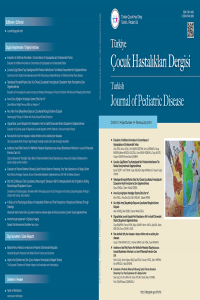Tekrarlayan Bronşioliti/Hışıltısı Olan Okul Öncesi Çocuklarda İmmünglobulin Düzeylerinin Hışıltı Fenotiplerine Göre Değerlendirilmesi
Öz
Amaç: Tekrarlayan bronşiolit/hışıltı okul öncesi dönemde sık görülmektedir. Epizodik hışıltı ve çoklu tetikleyici hışıltı
fenotipleri tanımlanmıştır. Çalışmamızın amacı, epizodik hışıltı (EH) ve çoklu tetikleyici hışıltısı (ÇTH) olan çocukların
immünglobulin düzeylerinde fark olup olmadığını belirlemektir.
Gereç ve Yöntemler: Tekrarlayan bronşiolit/hışıltısı olan 4 yaş altındaki son bir yılda en az 3 bronşiolit/hışıltı atağı
geçirmiş olan çocuklar çalışmaya alındı. Hastalar fenotiplere göre epizodik ve çoklu tetikleyici hışıltı olarak iki grupta
incelendi. Eozinofil sayısı, eozinofil yüzdesi, immünglobulin (Ig) A, G, M düzeyleri kayıt edildi.
Bulgular: Tekrarlayan bronşioliti/hışıltısı olan 86 çocuk (55 erkek, 31 kız) çalışmaya alındı. IgA düzeyi EH (43.3±35 mg/
dl) olan grupta ÇTH grubuna (74.1±45.1 mg/dl) göre daha düşük bulundu (p<0.001). IgG düzeyi de EH grubunda
(565.4±173.7 mg/dl) ÇTH grubuna (769.9±198.8 mg/dl) göre daha düşüktü (p<0.001). İmmünglobulin düşüklüğü sıklığı
EH grubunda (n=12, %37.5) ÇTH grubuna (n=4, %7.4) göre daha fazlaydı (p<0.001).
Sonuç: Tekrarlayan bronşiolit/hışıltısı olan çocuklarda immünglobulin düzeylerine bakılmalı ve takip edilmelidir. Epizodik
hışıltıda immünglobulin seviyelerindeki düşüklüğün de enfeksiyon sıklığını arttırarak hışıltıya yatkınlığa neden olabileceğini
düşündürmektedir.
Anahtar Kelimeler
Kaynakça
- 1.Martinez FD, Wright AL, Taussig LM, Holberg CJ, Halonen M, Morgan WJ. Asthma and wheezing in the first six years of life. The Group Health Medical Associates. N Engl J Med 1995;332:133-8.
- 2. Whelan MA, Hwan WH, Beausoleil J, Hauck WW, McGeady SJ. Infants presenting with recurrent infections and low immunoglobulins: characteristics and analysis of normalization. J Clin Immunol 2006;26:7-11.
- 3. Kocacık Uygun DF, Filiz S, Yeğin O. Süt çocukluğunun geçici hipogamaglobulinemi ön tanılı olgularımızın değerlendirilmesi. J Pediatr Res 2015;2:128-33.
- 4. Taussing LM, Wright AL, Holberg CJ, Halonen M, Morgan WS, Martinez FD, et al. Tuscon Children’s Respiratory Study: 1980 to present. J Allergy Clin Immunol 2003; 111:661-75.
- 5. Brand PL, Baraldi E, Bisgaard H, Boner AL, Castro-Rodriguez JA, Custovic A, et al. Definition, assessment and treatment of wheezing. Eur Respir J 2008;32:1096-110.
- 6. Tezcan I, Berkel AI, Ersoy F, Sanal O. Serum immunoglobulin levels with turbidimetric method in healthy Turkish children and adults. Turkish J Pediatr Dis 1996;39:649-56.
- 7. Castro-Rodriguez JA. The Asthma Predictive Index: A very useful tool for predicting asthma in young children. J Allergy Clin Immunol 2010;126:212-6.
- 8. Guilbert TW, Morgan WJ, Krawiec M, Lemanske RF. The Prevention of Early Asthma in Kids study: design, rationale and methods for the Childhood Asthma Research and Education network. Control Clin Trials 2004;25:286-310.
Ayrıntılar
| Birincil Dil | Türkçe |
|---|---|
| Konular | İç Hastalıkları |
| Bölüm | ORIGINAL ARTICLES |
| Yazarlar | |
| Yayımlanma Tarihi | 30 Temmuz 2019 |
| Gönderilme Tarihi | 27 Temmuz 2018 |
| Yayımlandığı Sayı | Yıl 2019 Cilt: 13 Sayı: 4 |

